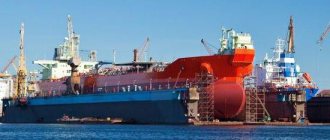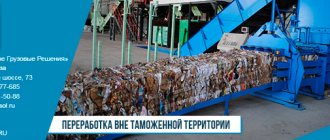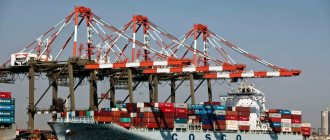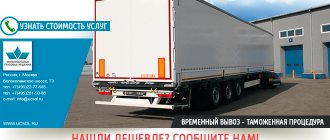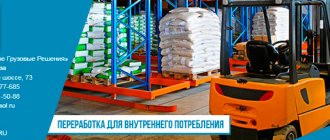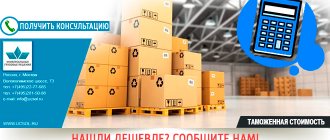Home Customs procedures
Customs procedures (formerly: customs regime, TR) are a set of rules that define, for customs purposes, the requirements and conditions for the use and (or) disposal of goods in the customs territory of the Customs Union or beyond its borders. (Article 2 of the EAEU Labor Code). Knowledge of the specifics of customs procedures is necessary to carry out any foreign trade operations with goods, be it the export of domestic products abroad (export), or, conversely, the import of foreign goods (import, customs transit). Without knowing the specifics of the chosen customs procedure, it is impossible to fill out a customs declaration and calculate the amount of customs duties. Therefore, before proceeding with a foreign trade transaction, a foreign trade participant must study the customs legislation of the country of registration and become familiar in advance with all the conditions and requirements that the selected customs procedure (CP) provides for. Otherwise, there is a high risk of the goods being delayed at customs and problems with paperwork. Therefore, it is necessary to know in advance under which customs procedure the imported or exported goods should be placed. The most popular, as a rule, are: release for domestic consumption, export, customs transit, temporary import, temporary export.
List of customs procedures
Today, according to the EAEU Customs Code, there are 17 customs procedures:
- Release for domestic consumption
- Export
- Customs transit
- Temporary import (admission)
- Temporary removal
- Processing in customs territory
- Processing outside the customs territory
- Processing for domestic consumption
- bonded warehouse
- Free warehouse
- Re-export
- Re-import
- Destruction
- Refusal in favor of the state
- Special customs procedure
- Free trade
- Free customs zone
Do you need help choosing a customs procedure and clearance at customs? - We will help you!
Features and procedure for placing goods under the customs procedure
The movement of goods across the customs border can be carried out by any participants in foreign trade activities: individuals, legal entities or individual entrepreneurs.
Goods may be transported in accompanied baggage or unaccompanied baggage (via a carrier or international mail). And all of them are subject to registration at places of customs clearance and control: temporary storage warehouses, electronic declaration centers (EDC), checkpoints across the state border, by submitting information to a customs inspector. Legal entity or individual entrepreneur: customs clearance of goods can be carried out only by submitting a customs declaration in electronic form through a special customs program. This can be carried out independently by the declarant - a participant in foreign trade activities or by a customs representative hired by him. At the same time, when importing goods into the Russian Federation, the necessary import customs duties are paid: customs clearance fees, duties, VAT, and for supplies worth up to 200 euros, customs duties are not paid! When exporting goods abroad, the Russian government exempted people from paying customs duties.
Individuals: carry out customs clearance at the checkpoint or customs posts for accompanied or unaccompanied baggage by submitting a passenger customs declaration independently or through a customs representative on the basis of a concluded brokerage agreement. When exported, goods are not subject to customs duties. And when importing goods into the Russian Federation, there are rules in accordance with Decision No. 107 of December 20, 2017 of the Council of the Eurasian Economic Commission “On certain issues related to goods for personal use.”
Stop searching!
We already have everything you need!
- Best price
- All countries and modes of transport
- All types of cargo and goods
- Convenient and fast communication
+7 (495) 478-00-48
Svetlana Markova
Foreign trade specialist
Article 128. Placement of goods under the customs procedure
The persons specified in Article 83 of this Code have the right to choose the customs procedure provided for by this Code by declaring it during the customs declaration of goods, or when declaring goods for release before submitting a declaration for goods, or by importing goods into the territory of a port SEZ or logistics SEZ. The placement of goods under the customs procedure begins from the moment of submission to the customs authority of a customs declaration or application for the release of goods before filing a declaration for goods, unless otherwise established by this Code, and ends with the release of goods, except for the case provided for in paragraph 1 of Article 204 of this Code. The day of placing goods under the customs procedure is considered the day of release of goods, except for the case provided for in paragraph 1 of Article 204 of this Code. The responsibility for confirming compliance with the conditions for placing goods under the declared customs procedure rests with the declarant. Goods subject to sanitary-quarantine, veterinary, quarantine-phytosanitary and other types of state control (supervision) are placed under the customs procedure only after the implementation of the corresponding type of state control (supervision). If, when introducing a non-tariff regulation measure, customs procedures are determined under which the placement of goods in respect of which such a measure is introduced is not allowed, then these goods are not subject to placement under such customs procedures, regardless of the provisions of this section.
Article 129. Completion, termination, suspension and resumption of customs procedures
The action of customs procedures is subject to completion in the cases, procedure and terms established by this Code, and if this is provided for by this Code, by the Commission or the legislation of the Member States on customs regulation. The action of the customs procedure is considered completed before the expiration of the validity period of the customs procedure established by the customs authority if the customs declaration submitted to place goods under the customs procedure in order to complete the action of this customs procedure is registered by the customs authority within the period specified for completion of the customs procedure, except in the case of when the customs authority refuses to release goods in accordance with the declared customs procedure or the customs declaration is revoked in accordance with Article 113 of this Code. In the event of the liquidation of a person who is a declarant of goods placed under a customs procedure, the legislation of the Member States may establish a different period before the expiration of which the customs procedure must be completed than provided for by this Code, and persons who are entrusted with the obligation to complete the customs procedure may also be determined. actions of the customs procedure. The validity of customs procedures is terminated in the cases, procedure and terms established by this Code, and if provided for by this Code, by the Commission or the legislation of the Member States on customs regulation. In cases provided for by this Code, goods placed under a customs procedure that has been terminated, as well as goods received (formed), manufactured (received) within the framework of the application of such a customs procedure, are detained by customs authorities in accordance with Chapter 51 of this Code. Goods placed under a customs procedure that has been terminated, as well as goods received (formed), manufactured (received) within the framework of the application of such a customs procedure, not detained by customs authorities in accordance with paragraph 5 of this article, are subject to temporary storage in accordance with with Chapter 16 of this Code. Foreign goods located in the customs territory of the Union, in respect of which the customs procedure has been terminated, for further location and use in the customs territory of the Union or export from the customs territory of the Union are subject to placement under customs procedures applicable to foreign goods, except for the cases provided for by this Code. . Goods received (formed), manufactured (received) within the framework of the application of customs procedures, the validity of which has been terminated, for further location and use in the customs territory of the Union, export from the customs territory of the Union or import into such territory are subject to placement under the customs procedures applicable in relation to these goods depending on the status they acquired during the period of customs procedures, except for the cases provided for by this Code. Goods located outside the customs territory of the Union, in respect of which the customs procedure has been terminated, for further stay outside the customs territory of the Union are subject to placement under the customs procedures applicable to goods of the Union, and for import into the customs territory of the Union - under the customs procedures applicable in regarding foreign goods. When placing goods under customs procedures in accordance with paragraph 7 of this article after the termination of customs procedures in relation to such goods, the provisions of this Code are applied without taking into account the specifics of calculation and payment of customs duties, taxes, special, anti-dumping, countervailing duties provided for by this Code, which are applied when placing goods under customs procedures to complete the relevant customs procedures, with the exception of the features provided for in Article 226 of this Code. The operation of a customs procedure may be suspended by placing goods placed under a customs procedure, or products of processing of such goods under another customs procedure, as well as in the case provided for in paragraph 1 of Article 133 of this Code. Customs procedures that are applied to suspend the operation of other customs procedures, as well as cases when the operation of a customs procedure may be suspended, are determined by this Code, and if provided for by this Code, by the Commission. The procedure for suspending and resuming customs procedures in established cases is determined by the Commission.
Types of customs procedures
Types of customs procedures can be divided into 4 groups: basic, economic, final and special. The latter regulate all those foreign economic transactions not covered by the other four. Let's look at each one in order as part of its own group.
The main customs regimes are the most in demand, because they regulate operations that are familiar and understandable to many, such as the purchase of foreign goods abroad or the sale of Russian goods abroad, their transportation and customs clearance.
- Release for domestic consumption;
- Export;
- Customs transit.
Economic procedures are more complex from a practical point of view, since they regulate such economic transactions as temporary import into the customs territory or export of goods outside of it for the purpose of processing.
- Processing in customs territory;
- Processing outside the customs territory;
- Processing for domestic consumption;
- Bonded warehouse;
- Temporary import (admission);
- Free warehouse.
The purpose of final procedures is to complete operations begun using such economic regimes as “temporary import”, “temporary export”, “processing outside the customs territory”. Other customs regimes from this group are aimed at the immediate termination of activities unilaterally, for example, when the cargo is confiscated - “refusal in favor of the state”, or destroyed - “destruction”.
- Re-export;
- Re-import;
- Destruction;
- Refusal in favor of the state.
The conditions for special customs procedures are stipulated by separate legislative acts. For example, the EAEU member countries (Russia, Belarus, Kazakhstan, Kyrgyzstan, Armenia) have concluded interstate agreements that stipulate that participants in foreign economic activity registered on their territories have the right to duty-free trade within the customs territory of the Customs Union. A similar international agreement is in force between the CIS countries, where foreign trade participants from one state (subject to certain conditions) can import goods duty-free into the territory of another CIS state.
- Temporary removal;
- Special customs procedure;
- Free trade;
- Free customs zone.
Customs declaration and customs procedures
Customs declaration
Goods are subject to customs declaration when they are placed under the customs procedure or goods for personal use that are subject to customs declaration, supplies and vehicles for international transportation (in some cases determined by Chapter 38 of the Customs Code of the Eurasian Economic Union) without being placed under the customs procedure.
Customs declaration is carried out in electronic form.
Customs declaration in writing is allowed:
1) when placing goods under the customs procedure of customs transit;
2) in relation to goods for personal use;
3) in relation to goods sent by international mail;
4) in relation to vehicles of international transport;
5) when used as a customs declaration of transport (transportation), commercial and (or) other documents, including those provided for in international treaties of the Member States with a third party;
6) in other cases determined by the Commission and the legislation of the Member States on customs regulation in cases provided for by the Commission.
Regardless of the above cases, a customs declaration in writing can be carried out if the customs authority does not have the opportunity to ensure that the declarant carries out the customs declaration in electronic form due to a malfunction of the information systems used by the customs authorities caused by technical failures, disruptions in the operation of communications (telecommunication networks) and the Internet), power outages, as well as in other cases established by the legislation of the Member States.
Types of customs declaration:
1. The declaration for goods is used when placing goods under customs procedures (with the exception of the customs procedure for customs transit) and in some cases when customs declaring supplies (Decision of the Customs Union Commission dated May 20, 2010 No. 257).
The declaration of goods for express cargo is used for customs declaration by a customs representative of goods delivered by the carrier as express cargo (Decision of the Board of the Eurasian Economic Commission dated August 28, 2018 No. 142).
As a declaration for goods, it is allowed to use transport (transportation), commercial and (or) other documents, including those provided for in international treaties of the Member States with a third party, containing information necessary for the release of goods, in cases and in the manner determined by the Customs Code of the Eurasian economic union (hereinafter referred to as the Union), international treaties of the member states with a third party and (or) the Commission and the legislation of the member states in cases provided for by the Commission (Decision of the Customs Union Commission dated 20.05.2010 No. 263, Decision of the Board of the Eurasian Economic Commission dated 25.12 .2012 No. 290).
When customs declaring goods sent in international mail, in accordance with the customs procedure for release for domestic consumption, documents provided for by the acts of the Universal Postal Union and accompanying international mail may be used as a declaration for goods in the following cases:
1) customs duties and taxes are not subject to payment in respect of such goods;
2) prohibitions and restrictions are not established in relation to such goods, and measures to protect the domestic market are not applied.
When customs declaring goods sent in international mail, in accordance with the customs procedure for export, as well as in accordance with the customs procedure for re-import, goods exported from the customs territory of the Union in international mail and not delivered to recipients can be used as a declaration for goods documents provided for by the acts of the Universal Postal Union and accompanying international postal items, in cases and conditions established by the legislation of the member states.
2. The transit declaration is used when placing goods under the customs procedure of customs transit (Decision of the Customs Union Commission dated June 18, 2010 No. 289).
As a transit declaration, it is allowed to use transport (transportation), commercial and (or) other documents, including those provided for in international treaties of the Member States with a third party, containing information necessary for the release of goods, in cases and in the manner determined by the Customs Code of the Union, international treaties of the Member States with a third party and (or) the Commission and the legislation of the Member States in cases provided for by the Commission.
As a transit declaration, it is permitted to use preliminary information presented in the form of an electronic document in the manner determined by the Commission (Decision of the Board of the Eurasian Economic Commission dated December 25, 2018 No. 214).
3. The passenger customs declaration is used for customs declaration of goods for personal use, and when placing goods for personal use under the customs procedure of customs transit (Decision of the Board of the Eurasian Economic Commission dated July 23, 2019 No. 124).
The passenger customs declaration for express cargo is used for customs declaration by a customs representative of goods for personal use delivered by the carrier as express cargo (Decision of the Board of the Eurasian Economic Commission dated October 16, 2018 No. 158).
When customs declaring goods sent in international mail, documents provided for by the acts of the Universal Postal Union and accompanying international mail can be used as a passenger customs declaration.
4. The vehicle declaration is used for customs declaration of vehicles for international transportation and in some cases for customs declaration of supplies (Decision of the Customs Union Commission dated October 14, 2010 No. 422).
The carrier's standard documents provided for in the international agreements of the Member States with third parties in the field of transport can be used as a declaration for the vehicle.
As a declaration for a vehicle, it is permitted to use preliminary information presented in the form of an electronic document in the manner determined by the Commission (Decision of the Board of the Eurasian Economic Commission dated December 25, 2018 No. 214).
Customs procedures
Depending on the purposes of location and use of goods in the customs territory of the Union, their export from the customs territory of the Union and (or) location and use outside the customs territory of the Union, the following customs procedures are applied:
| Release for domestic consumption | customs procedure applied in relation to foreign goods, according to which goods are located and used in the customs territory of the Union without restrictions on possession, use and (or) disposal of them provided for by international treaties and acts in the field of customs regulation in relation to foreign goods, if otherwise not established by the Customs Code of the Union |
| Export | customs procedure applied to goods of the Union, according to which such goods are exported from the customs territory of the Union for permanent residence outside its borders |
| Customs transit | customs procedure, according to which goods are transported (transported) from the customs authority of departure to the customs authority of destination without paying customs duties, taxes, special, anti-dumping, countervailing duties, subject to the conditions for placing goods under this customs procedure |
| Customs warehouse | customs procedure applied to foreign goods, according to which such goods are stored in a customs warehouse without paying import customs duties, taxes, special, anti-dumping, countervailing duties, subject to the conditions for placing the goods under this customs procedure and their use in accordance with such customs procedures. At the same time, the Commission has the right to determine the list of goods in respect of which the customs procedure of a customs warehouse is not applied (Decision of the Board of the Eurasian Economic Commission dated December 11, 2018 No. 203). |
| Processing in customs territory | customs procedure applied in relation to foreign goods, according to which processing operations are carried out with such goods on the customs territory of the Union in order to obtain products of their processing intended for subsequent export from the customs territory of the Union, without paying import customs duties in relation to such foreign goods duties, taxes, special, anti-dumping, countervailing duties, subject to the conditions for placing goods under this customs procedure and their use in accordance with such a customs procedure. At the same time, the Commission: - has the right to determine the list of goods for which the customs procedure of processing in the customs territory is not applied ( Decision of the Board of the Eurasian Economic Commission dated December 11, 2018 No. 203 ); — determines a longer (over 3 years) processing period for certain categories of goods in the customs territory of the Union (Decision of the Board of the Eurasian Economic Commission dated December 11, 2018 No. 203). |
| Processing outside the customs territory | customs procedure applied to goods of the Union, according to which such goods are exported from the customs territory of the Union in order to obtain, as a result of processing operations outside the customs territory of the Union, products of their processing intended for subsequent import into the customs territory of the Union, without paying in relation to such goods of the Union of export customs duties, subject to the conditions for placing the goods under this customs procedure and their use in accordance with such a customs procedure. At the same time, the Commission has the right to determine the list of goods for which the customs procedure for processing outside the customs territory is not applied (Decision of the Board of the Eurasian Economic Commission dated December 11, 2018 No. 203). |
| Processing for domestic consumption | customs procedure applied to foreign goods, according to which processing operations are carried out with such goods for domestic consumption in order to obtain products of their processing intended for subsequent placement under the customs procedure of release for domestic consumption, without payment in relation to such foreign goods import customs duties, subject to the conditions for placing goods under this customs procedure and their use in accordance with such customs procedure. At the same time, the customs procedure for processing for domestic consumption is applied to goods, the list of which is established by the legislation of the Member States. |
| Free customs zone | customs procedure applied to foreign goods and goods of the Union, according to which such goods are placed and used within the territory of the FEZ or part thereof without paying customs duties, taxes, special, anti-dumping, countervailing duties, subject to the conditions for placing goods under this customs procedure and their use in accordance with such customs procedure. At the same time, the Commission has the right to determine the list of goods and (or) categories of goods that are not subject to placement under the customs procedure of a free customs zone (Decision of the Council of the Eurasian Economic Commission dated April 29, 2019 No. 45). In accordance with the legislation of the Member States, a list of goods and (or) categories of goods that are not subject to placement under the customs procedure of a free customs zone in SEZs created (being created) in the territories of these states may be established. |
| Free warehouse | customs procedure applied to foreign goods and goods of the Union, according to which such goods are placed and used in a free warehouse without paying customs duties, taxes, special, anti-dumping, countervailing duties, subject to the conditions for placing goods under this customs procedure and their use in accordance with such customs procedure. At the same time, the Commission has the right to determine the list of goods and (or) categories of goods in respect of which the customs procedure of a free warehouse is not applied (Decision of the Council of the Eurasian Economic Commission dated April 29, 2019 No. 45). |
| Temporary import (admission) | a customs procedure applied to foreign goods, according to which such goods are temporarily located and used in the customs territory of the Union, subject to the conditions for placing the goods under this customs procedure and their use in accordance with such a customs procedure, with partial payment of import customs duties, taxes and without paying special, anti-dumping, countervailing duties or without paying import customs duties, taxes and without paying special, anti-dumping, countervailing duties. At the same time, categories of goods whose temporary presence and use in the customs territory of the Union in accordance with the customs procedure for temporary import (admission) are allowed without paying import customs duties, taxes, the conditions for such temporary stay and use, as well as the deadlines for such temporary stay and use are determined by the Commission and (or) international treaties of the member states with a third party (Decision of the Customs Union Commission dated 20.09. 2010 No. 375, Decision of the Customs Union Commission dated June 18, 2010 No. 331, Decision of the Council of the Eurasian Economic Commission dated December 20, 2017 No. 109). |
| Temporary removal | customs procedure applied to goods of the Union, according to which such goods are exported from the customs territory of the Union for their temporary stay and use outside it without paying export customs duties, subject to the conditions for placing the goods under this customs procedure and their use in accordance with such customs procedure. At the same time, the Commission has the right to determine the categories of temporarily exported goods in respect of which their replacement with foreign goods is allowed, as well as cases of such replacement. |
| Re-import | customs procedure applied to foreign goods, according to which such goods, previously exported from the customs territory of the Union, are imported into the customs territory of the Union without paying import customs duties, taxes, special, anti-dumping, countervailing duties, subject to the conditions for placing goods under this customs procedure. Moreover, in relation to certain categories of goods, the Commission has the right to determine the period for placing goods under the customs procedure of re-import, exceeding the period established by the Customs Code of the Union ( Decision of the Board of the Eurasian Economic Commission dated December 11, 2018 No. 203 ). |
| Re-export | customs procedure applied to foreign goods and goods of the Union, according to which foreign goods are exported from the customs territory of the Union without paying import customs duties, taxes, special, anti-dumping, countervailing duties and (or) with a refund (offset) of the amounts of such duties and taxes, and Union goods - without paying export customs duties, subject to the conditions for placing goods under this customs procedure. |
| Duty free trade | customs procedure applied to foreign goods and goods of the Union, according to which such goods are located and sold at retail in duty-free stores without paying import customs duties, taxes, special, anti-dumping, countervailing duties in relation to foreign goods, subject to the conditions of the premises goods under this customs procedure and their use in accordance with such customs procedure. At the same time, the Commission has the right to determine a list of goods other than those provided for by the Customs Code of the Union, in respect of which the customs procedure of duty-free trade is not applied ( Decision of the Board of the Eurasian Economic Commission dated December 11, 2018 No. 203 ). |
| Destruction | a customs procedure applied to foreign goods, according to which such goods are destroyed without paying import customs duties, taxes, special, anti-dumping, countervailing duties, subject to the conditions for placing the goods under such a customs procedure. At the same time, the Commission has the right to determine a list of goods other than those provided for by the Customs Code of the Union, in respect of which the customs destruction procedure is not applied. |
| Refusal in favor of the state | customs procedure applied to foreign goods, according to which such goods are transferred free of charge into the ownership (income) of a member state without paying import customs duties, taxes, special, anti-dumping, countervailing duties, subject to the conditions for placing goods under this customs procedure. |
| Special customs procedure | customs procedure applied in relation to certain categories of foreign goods and goods of the Union, according to which such goods are moved across the customs border of the Union, are located and (or) used in the customs territory of the Union or outside its borders without paying customs duties, taxes, special , anti-dumping, countervailing duties, subject to the conditions for placing goods under this customs procedure and (or) their use in accordance with such a customs procedure. At the same time, the Commission has the right to determine other categories of goods in respect of which a special customs procedure is applied, including goods related or not related to these categories of goods, and also determines the conditions for placing goods under a special customs procedure and the procedure for applying the special customs procedure (Decision of the Commission of the Customs Union dated 20.05.2010 No. 329, Decision of the Council of the Eurasian Economic Commission dated 29.03.2019 No. 23). |
Time limits for placing goods under the customs procedure
The time period for placing goods under a customs procedure is the period during which the declarant must declare the goods by submitting a declaration to the customs authority under the required customs procedure. Depending on its type, this period may vary (for example, for imported goods this period is 4 months. The right to choose one or another procedure belongs to the declarant and the owner of the cargo, and it is they who bear legal responsibility in case of non-compliance with its terms and requirements. According to the provisions of Art. 127 of the EAEU Labor Code, goods may be placed under other customs procedures. In this case, the declarant has the right to change the selected procedure to another (Article 127.3 of the EAEU Labor Code). Control over compliance with the conditions of the procedures is assigned to the customs authorities. After submitting the declaration, the customs inspector must within 1 hour to accept the customs declaration for work, or send it to the declarant for revision.
The day the goods are placed under the selected procedure is the day the goods are released by the customs authority.
Customs release of goods is an action of customs authorities allowing interested parties to use goods in accordance with the terms of the declared procedure or in accordance with the conditions established for certain categories of goods that are not subject to placement under customs regimes in accordance with this Code (Article 2 of the EAEU Labor Code).
Eurasian Economic Commission
Article 173. The procedure for performing customs operations related to the placement of goods under the customs procedure
1. Customs operations related to the placement of goods under the customs procedure are carried out in the manner and under the conditions determined by the customs legislation of the Customs Union, and in cases established by this Code or other international treaties of the member states of the Customs Union - by the legislation of the member states of the Customs Union .
(clause 1 as amended by the Protocol dated April 16, 2010)
2. The procedure and technology for performing customs operations related to the placement of goods under the customs procedure, depending on the type of goods moved across the customs border, the type of transport used for such movement (road, air, rail, sea, river and others), and also, the categories of persons moving goods are established by the customs legislation of the Customs Union and (or) the legislation of the member states of the Customs Union.
The procedure and technology for carrying out customs operations, determined by the legislation of the member states of the Customs Union, should not lead to full or partial exemption from the payment of import customs duties and the application of non-tariff regulation measures, anti-dumping, countervailing and special protective measures.
(clause 2 as amended by the Protocol dated April 16, 2010)
3. On behalf of the customs authorities, customs operations related to the placement of goods under the customs procedure are carried out by officials of customs authorities authorized to carry out such customs operations in accordance with their official (functional) responsibilities.
4. The requirements of customs authorities when carrying out customs operations related to the placement of goods under the customs procedure must be justified and limited to the requirements necessary to ensure compliance with the customs legislation of the Customs Union.
5. Customs operations related to the placement of goods under the customs procedure are applied equally regardless of the country of origin, departure and destination of the goods.
Article 174. Placement of goods under the customs procedure
1. The placement of goods under the customs procedure begins from the moment of submission to the customs authority of the customs declaration and (or) documents necessary for the placement of goods under the customs procedure in the cases provided for by this Code.
2. Goods subject to veterinary, phytosanitary and other types of state control may be placed under the customs procedure only after appropriate control has been carried out.
3. The placement of goods under the customs procedure ends with the release of goods in accordance with the declared customs procedure.
Article 175. Place and time of customs operations related to the placement of goods under the customs procedure
1. Customs operations related to the placement of goods under the customs procedure are carried out at the locations of customs authorities and during their work.
2. At the motivated request of the declarant or customs representative, certain customs operations related to the placement of goods under the customs procedure may be carried out outside the location and outside the working hours of the customs authorities.
Article 176. Documents and information necessary for placing goods under the customs procedure
1. When placing goods under a customs procedure, persons determined by this Code are required to submit to the customs authorities the documents and information necessary for the release of goods.
When performing customs operations related to the placement of goods under a customs procedure, customs authorities have the right to require the submission of only documents and information that are necessary to ensure compliance with the customs legislation of the Customs Union and the submission of which is provided for by the customs legislation of the Customs Union.
2. The list of documents and information required for the release of goods and the deadlines for their submission are established by this Code.
3. Customs authorities do not have the right to refuse to accept documents due to the presence of typos, technical or grammatical errors that do not change the data contained in the documents that influence the customs authority’s decision to release goods.
4. Documents necessary for the release of goods may be submitted in the form of electronic documents in accordance with this Code.
5. The forms of customs documents are determined by a decision of the Commission of the Customs Union.
Customs documents are filled out in Russian, unless otherwise established in accordance with this Code.
6. In accordance with international treaties of the member states of the Customs Union and international treaties of the member states of the Customs Union with foreign states, in order to simplify and speed up the release of goods, customs documents of other states used for customs purposes may be used.
Article 177. Presence of interested persons or their representatives during customs operations related to the placement of goods under the customs procedure
1. Interested persons or their representatives have the right to be present during customs operations related to the placement of goods under the customs procedure.
2. At the request of the customs authority, interested persons or their representatives are required to be present during customs operations related to the placement of goods under the customs procedure, in order to assist the customs authorities in their implementation.
Article 178. Priority procedure for placing certain categories of goods under the customs procedure
(as amended by the Protocol dated April 16, 2010)
Goods necessary to eliminate the consequences of natural disasters, natural and man-made emergencies, military products necessary for peacekeeping activities or training exercises, as well as perishable goods, live animals, radioactive materials, explosives, international postal shipments, express cargo, humanitarian and technical assistance, communications and materials for the media, spare parts, engines, consumables, equipment and tools necessary for the repair of international transport vehicles, and other similar goods are placed under the customs procedure as a matter of priority .
Cost of customs clearance services
Our company provides services for customs clearance of any cargo and goods of foreign trade participants at any customs offices of the Russian Federation in any customs procedures.
The time it takes to clear the cargo at customs usually takes several hours!
The cost of customs clearance of goods in our company is minimal in the market and depends on the type of customs procedure in which the goods are cleared and the customs locations, and on average ranges from 3,000 to 20,000 rubles.
We are ready to become your reliable partner at customs!
VIRTUAL CUSTOMS CUSTOMS AND LOGISTICS PORTAL
Article 173. The procedure for performing customs operations related to the placement of goods under the customs procedure
1. Customs operations related to the placement of goods under the customs procedure are carried out in the manner and under the conditions determined by the customs legislation of the customs union, and in cases established by this Code or other international treaties of the member states of the customs union - by the legislation of the member states of the customs union .
(as amended by the Protocol dated April 16, 2010)
2. The procedure and technology for performing customs operations related to the placement of goods under the customs procedure, depending on the type of goods moved across the customs border, the type of transport used for such movement (road, air, rail, sea, river and others), and also, the categories of persons moving goods are established by the customs legislation of the customs union and (or) the legislation of the member states of the customs union.
The procedure and technology for performing customs operations, determined by the legislation of the member states of the customs union, should not lead to exemption in whole or in part from the payment of import customs duties and the application of non-tariff regulation measures, anti-dumping, compensation and special protective measures.
(clause 2 as amended by the Protocol dated April 16, 2010)
3. On behalf of the customs authorities, customs operations related to the placement of goods under the customs procedure are carried out by officials of customs authorities authorized to carry out such customs operations in accordance with their official (functional) responsibilities.
4. The requirements of customs authorities when carrying out customs operations related to the placement of goods under the customs procedure must be justified and limited to the requirements necessary to ensure compliance with the customs legislation of the Customs Union.
5. Customs operations related to the placement of goods under the customs procedure are applied equally regardless of the country of origin, departure and destination of the goods.
Article 174. Placement of goods under the customs procedure
1. The placement of goods under the customs procedure begins from the moment of submission to the customs authority of the customs declaration and (or) documents necessary for the placement of goods under the customs procedure in the cases provided for by this Code.
2. Goods subject to veterinary, phytosanitary and other types of state control may be placed under the customs procedure only after appropriate control has been carried out.
3. The placement of goods under the customs procedure ends with the release of goods in accordance with the declared customs procedure.
Article 175. Place and time of customs operations related to the placement of goods under the customs procedure
1. Customs operations related to the placement of goods under the customs procedure are carried out at the locations of customs authorities and during their work.
2. At the motivated request of the declarant or customs representative, certain customs operations related to the placement of goods under the customs procedure may be carried out outside the location and outside the working hours of the customs authorities.
Article 176. Documents and information necessary for placing goods under the customs procedure
1. When placing goods under a customs procedure, persons determined by this Code are required to submit to the customs authorities the documents and information necessary for the release of goods.
When performing customs operations related to the placement of goods under a customs procedure, customs authorities have the right to require the submission of only documents and information that are necessary to ensure compliance with the customs legislation of the Customs Union and the submission of which is provided for by the customs legislation of the Customs Union.
2. The list of documents and information required for the release of goods and the deadlines for their submission are established by this Code.
3. Customs authorities do not have the right to refuse to accept documents due to the presence of typos, technical or grammatical errors that do not change the data contained in the documents that influence the customs authority’s decision to release goods.
4. Documents necessary for the release of goods may be submitted in the form of electronic documents in accordance with this Code.
5. The forms of customs documents are determined by a decision of the Customs Union Commission.
Customs documents are filled out in Russian, unless otherwise established in accordance with this Code.
6. In accordance with international treaties of the member states of the customs union and international treaties of the member states of the customs union with foreign states, in order to simplify and speed up the release of goods, customs documents of other states used for customs purposes may be used.
Article 177. Presence of interested persons or their representatives during customs operations related to the placement of goods under the customs procedure
1. Interested persons or their representatives have the right to be present during customs operations related to the placement of goods under the customs procedure.
2. At the request of the customs authority, interested persons or their representatives are required to be present during customs operations related to the placement of goods under the customs procedure, in order to assist the customs authorities in their implementation.
Article 178. Priority procedure for placing certain categories of goods under the customs procedure
Goods necessary to eliminate the consequences of natural disasters, natural and man-made emergencies, military products necessary for peacekeeping activities or training exercises, as well as perishable goods, live animals, radioactive materials, explosives, international postal shipments, express cargo, humanitarian and technical assistance, communications and materials for the media, spare parts, engines, consumables, equipment and tools necessary for the repair of international transport vehicles, and other similar goods are placed under the customs procedure as a matter of priority .
(as amended by the Protocol dated April 16, 2010)
